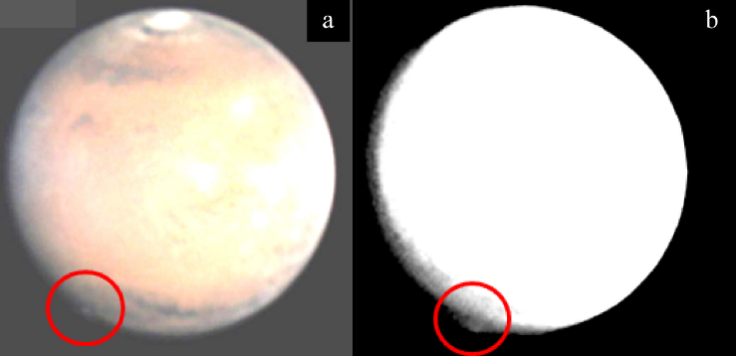Gigantic, High-Altitude Plume On Mars Leaves Scientists Puzzled

On March 12, 2012, a group of amateur astronomers observed a gigantic plume, visible as a small protrusion, above the surface of Mars. What made this mysterious haze stand out is the fact that though the plume was visible for 11 consecutive days -- from March 12 to March 23 -- scientists have not been able to figure out what gave rise to the formation, which at one point of time, was reportedly spread over a distance of more than 600 miles in the Martian atmosphere.
“Clouds of ice crystals have been observed numerous times by spacecraft and ground-based telescopes, showing that clouds are typically layered and always confined below an altitude of 100 kilometers (62 miles),” a team of scientists investigating the sightings wrote in a paper, published Monday in the journal Nature. However, the plumes were found to be present at a much greater height -- nearly 170 miles above the surface of the planet.

“This analysis shows the extreme altitude of the plume top to be above 200 km, never before observed on Mars, and reaching the ionosphere and exosphere,” the researchers wrote in the paper. Moreover, the formation was found to have “day-to-day variability” and it changed shape from dawn to dusk.
“The fact that it was seen by multiple observers suggests pretty strongly that it's real,” Bruce Jakosky from the University of Colorado, who was not involved in the research, told National Geographic. “But I find the observation puzzling.”
In order to explain this “puzzling” observation, scientists have come up with two possible explanations, although both of them defy our current understanding of Mars’ upper atmosphere.
“First, we assume that the plume is a cloud formed by particles of water-ice, carbon dioxide-ice or dust,” the researchers wrote in the paper. However, given the extremely high altitude at which the plume was observed, current knowledge suggests that the Martian atmosphere is too thin for the formation of any plumes.
“In the second scenario, we explored whether the 2012 plume might be attributable to an aurora,” the scientists wrote, referring to a Martian version of the northern or southern lights. This hypothesis fails to explain the observed brightness of the plume, which exceeded the brightness of previous auroras seen on Mars “by orders of magnitude.”
“It raises more questions than answers,” Antonio Garcia Munoz, a planetary scientist from the European Space Agency and a co-author of the study, told BBC. As of now, the scientists’ only hope is that the phenomenon would repeat itself, giving them an opportunity to either confirm or reject their hypotheses.
© Copyright IBTimes 2024. All rights reserved.






















